Introduction
Being able to select all on the keyboard is a useful skill that can save you time and effort when working with text and data on your computer. Whether you’re trying to highlight and delete a large chunk of text, copy and paste information, or perform a global search and replace, knowing how to select all can greatly streamline your workflow. In this article, we will explore different methods to select all using both Windows and Mac keyboards, as well as provide tips and tricks for selecting all on specific applications.
Selecting all allows you to effortlessly highlight every character, word, or element within a given context. It eliminates the need to manually scroll and click, providing a quick and convenient way to manipulate or manage large amounts of data. This command is especially handy when dealing with lengthy documents, spreadsheets, or web pages. By learning various techniques, you’ll be able to master the art of selecting all, boosting your productivity and efficiency.
No matter if you’re a student, professional, or casual computer user, the ability to select all on the keyboard is a fundamental skill that can benefit anyone who frequently works with text. By harnessing this capability, you can speed up your editing, formatting, and organizing tasks, making your work more seamless and enjoyable. So, let’s dive into the methods for selecting all on both Windows and Mac keyboards, as well as discover how to utilize this feature on popular applications.
Why do you need to select all on the keyboard?
The ability to select all on the keyboard is a vital skill that can greatly enhance your productivity and efficiency when working with text and data. Here are several reasons why knowing how to select all can be beneficial:
- Editing and Formatting: When you want to make global changes to a document, such as changing the font style or size, it’s much faster to select all the text at once rather than manually selecting each section.
- Deleting or Copying: Selecting all allows you to quickly delete or copy entire sections of text. This is especially useful when dealing with lengthy documents, saving you the time and effort associated with manually selecting each individual portion.
- Formatting Web Pages: If you’re a web developer or designer, selecting all enables you to quickly apply CSS styles or HTML tags to the entire document, ensuring consistent formatting and saving you from manually selecting each element.
- Data Manipulation: When working with tables or spreadsheets, selecting all allows you to perform operations on an entire column or row, such as sorting, filtering, or applying formulas.
- Searching and Replacing: If you need to find and replace a specific word or phrase in a document, selecting all makes it easier to perform a global search and replace, ensuring that every instance is modified.
By mastering the skill of selecting all on the keyboard, you can significantly streamline your workflow and eliminate the need for repetitive and time-consuming tasks. It’s a valuable technique that empowers you to work more efficiently with text and data, ultimately saving you precious time and energy.
How to select all using a Windows keyboard
Selecting all using a Windows keyboard is a simple and straightforward process. Here are a few different methods you can use:
- Using Keyboard Shortcuts: The most common method to select all on a Windows keyboard is by using the keyboard shortcut Ctrl + A. This combination will instantly highlight and select all the content within the active window or document.
- Using the Edit Menu: Another way to select all is by using the Edit menu option. First, click on the “Edit” tab located at the top of the window. Then, from the dropdown menu, select the “Select All” option. This will have the same effect as the Ctrl + A shortcut, highlighting all the content.
- Using the Context Menu: You can also select all by right-clicking anywhere within the document or window. A context menu will appear, and from the options provided, choose “Select All”. This action will select all the content within the active window.
Regardless of the method you choose, all the text or elements within the active window will be selected and ready to be edited, copied, or deleted with a simple click or keystroke. It’s important to note that the specific keyboard layout or software you’re using may affect the keyboard shortcuts, so be sure to check for any variations or customizations.
Now that you know how to select all using a Windows keyboard, let’s explore how to perform the same action using a Mac keyboard.
How to select all using a Mac keyboard
If you’re using a Mac keyboard, there are several methods you can use to select all. Here are a few different approaches:
- Using Keyboard Shortcuts: The primary keyboard shortcut to select all on a Mac keyboard is Command + A. Pressing this combination will instantly highlight and select all the content within the active window or document.
- Using the Edit Menu: Another way to select all on a Mac is by using the Edit menu. First, click on the “Edit” tab located at the top of the screen. Then, from the dropdown menu, select the “Select All” option. This will have the same effect as the Command + A shortcut, highlighting all the content.
- Using the Context Menu: Similar to Windows, you can also select all by right-clicking anywhere within the document or window. A context menu will appear, and from the options provided, choose “Select All”. This action will select all the content within the active window on your Mac.
Just like with a Windows keyboard, all the text or elements within the active window will be selected and ready to be edited, copied, or deleted with a simple click or keystroke.
It’s worth noting that the keyboard shortcuts and menus may vary slightly depending on the specific application or software you’re using on your Mac. However, the basic principle remains the same – using Command + A or the Select All option from the Edit menu to select all the content within the active window or document.
Now that you know how to select all using a Mac keyboard, let’s move on to exploring how to select all on various applications.
How to select all on various applications
While the methods to select all on Windows and Mac keyboards are generally consistent across most applications, some programs may have unique ways of executing this action. Let’s explore how to select all on several popular applications:
- Microsoft Word: To select all in Microsoft Word, you can either use the keyboard shortcut Ctrl + A or go to the “Home” tab, click on the “Select” option in the “Editing” group, and choose “Select All” from the dropdown menu.
- Excel: In Microsoft Excel, you can select all cells in a worksheet by pressing Ctrl + A. If you want to select only the data area (excluding empty cells or headers), press Ctrl + Shift + Spacebar.
- Google Docs: To select all in Google Docs, you can use the keyboard shortcut Ctrl + A. Alternatively, go to the “Edit” tab, click on “Select all” from the dropdown menu, or simply click and drag your cursor across the entire document.
- Adobe Photoshop: In Adobe Photoshop, you can select all by using the keyboard shortcut Ctrl + A. You can also go to the “Select” tab in the menu bar and choose “All” from the dropdown menu.
- TextEdit (Mac): In TextEdit, which is the default text editor on Mac, you can select all by using the keyboard shortcut Command + A or by going to the “Edit” menu and choosing the “Select All” option.
These are just a few examples, and the methods may vary depending on the application you’re using. Always check the application’s menu options or seek out specific instructions if you’re unsure of how to select all within a particular program.
With these techniques, you’ll be able to select all in a variety of applications, empowering you to manipulate and manage your content efficiently.
Tips and tricks for selecting all on the keyboard
While the basic methods of selecting all using keyboard shortcuts or menu options are fairly straightforward, there are a few tips and tricks that can further enhance your selection experience:
- Combine with other shortcuts: Selecting all becomes even more powerful when combined with other shortcuts. For example, after selecting all, you can use shortcuts like Ctrl + X to cut or Ctrl + C to copy the selected content.
- Use Shift for partial selection: If you only want to select a portion of the content, you can use the Shift key in combination with the selection methods. For example, hold down the Shift key and click at the starting point of the desired selection, then click at the endpoint. This will select the text or elements within that range.
- Scroll with precision: When working with lengthy documents or web pages, you may need to scroll while keeping the selection intact. To do this, hold down the Shift key and use either the arrow keys or the mouse scroll wheel to scroll through the content while maintaining the selection.
- Know your software’s capabilities: Different software applications may have specific features related to selecting all or selecting specific elements. Explore the documentation or help resources of the software you’re using to discover any additional selection options or techniques.
- Customize your keyboard shortcuts: Some applications allow you to customize keyboard shortcuts. If you find that the default shortcuts for selecting all don’t work well for you, check if the software offers options to modify the shortcuts according to your preferences.
By applying these tips and tricks, you can optimize your selection process and make it even more efficient. Experiment with different methods and shortcuts to find the ones that work best for your workflow and specific requirements.
Now that you’re armed with these tips and tricks, you’re well-equipped to make the most out of selecting all on your keyboard.
Conclusion
Mastering the skill of selecting all on the keyboard is a valuable asset that can greatly improve your productivity and efficiency when working with text and data. Whether you’re using a Windows keyboard or a Mac keyboard, the process is simple and can be executed through keyboard shortcuts, menu options, or context menus.
By selecting all, you can effortlessly edit, format, delete, copy, or manipulate large amounts of content within seconds. This skill is particularly useful in applications like Microsoft Word, Excel, Google Docs, Adobe Photoshop, and TextEdit for Mac, where selecting all is a common requirement.
Moreover, implementing tips and tricks, such as combining shortcuts, using the Shift key for partial selection, and customizing keyboard shortcuts, can enhance your selection experience and make it even more efficient.
So, whether you’re a student, professional, or casual computer user, being proficient in selecting all on the keyboard is a fundamental skill that can save you time and effort in various tasks.
Now that you have a comprehensive understanding of how to select all on the keyboard, from different keyboard layouts to various applications, it’s time to put this knowledge into practice. Start incorporating these techniques into your workflow and experience the benefits of quick and convenient selection.
Remember, the ability to select all is just one of the many keyboard shortcuts and skills you can learn to optimize your computer usage. Continuously exploring and expanding your knowledge will undoubtedly lead to increased productivity and a smooth workflow in your digital endeavors.

























